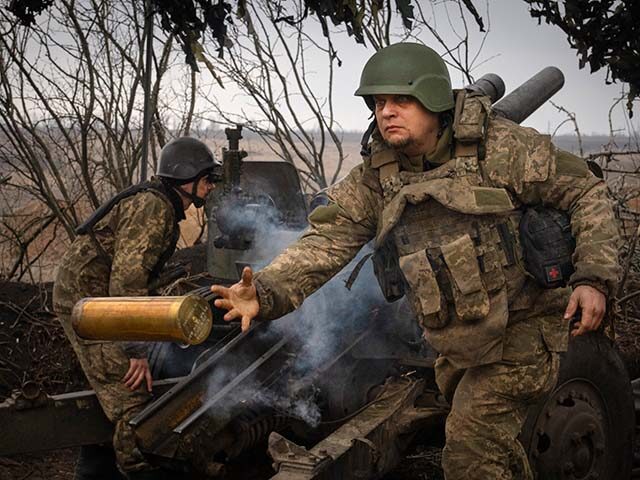The governor of the Russian region of Belgorod claimed on Tuesday that Ukrainian troops had launched an attempt to “break through the border,” potentially expanding the surprise ground campaign targeting neighboring Kursk that began on August 6.
The Ukrainian government began a campaign to seize land in Kursk, uncontested Russian territory, in early August that forced the Russian military to redirect resources out of war-torn eastern Ukraine and resulted in mass evacuations of Russian civilians from the border. After nearly three weeks of headlines suggesting that Ukraine had shifted the momentum to its benefit in the two-year-old full-scale invasion, the Russian government launched nationwide airstrikes in response, targeting the Ukrainian power grid.
Ukrainian President Volodymyr Zelensky announced on Monday that the country was facing blackouts “everywhere,” while electricity officials announced they would have to implement rolling power outages to ensure that enough electricity would go to essential services. The Russian government confirmed that it had targeted electrical infrastructure in an attempt to cripple the Ukrainian military.
Ukrainian authorities have not at press time addressed the reported attacks in Belgorod.
“There is information that the enemy is trying to break through the border of the Belgorod Region,” Governor Vyacheslav Gladkov announced on Tuesday, according to the Russian news network Tass. Russian authorities reportedly insisted that the situation was “under control,” though suggested that fighting was ongoing.
The Moscow Times reported that, in addition to official information, unofficial news on Russian regime-linked Telegram channels suggested that hundreds of Ukrainian soldiers were participating in assaults on the Belgorod border. One such account indicated that 200 Ukrainian troops had deployed “near” one border checkpoint and 300 near another. Neither the Russian nor Ukrainian government have confirmed those reports, however.
Belgorod is located southeast of Kursk, where the August Ukrainian ground initiative has largely focused, and 25 miles from the border with Kharkiv, Ukraine. Its location has made it vulnerable to Ukrainian attack throughout the war. Governor Gladkov offered to voluntarily relocate residents out of the region in January in the face of mounting Ukrainian attacks, seven months after the first large-scale reports of “paramilitary” fighting in the region. Deadly shelling in July, targeting locations the Russian military uses to fire into Ukraine, outraged local residents, who lamented to Al Jazeera that they did not feel that Moscow was protecting them. At the time, Gladkov claimed that over 200 Belgorod residents had died as a result of the war since 2022.
Gladkov declared a state of emergency in Belgorod on August 14 in response to the Kursk counter-invasion, which had also affected parts of his region.
“Houses are destroyed. Civilians died and were injured,” he said in his announcement, describing the situation in Belgorod as “extremely difficult and tense.”
In a meeting with Russian strongman Vladimir Putin shortly before the state of emergency declaration, Gladkov said his region had begun planning to evacuate as many as 11,000 people to protect from Ukrainian attacks.
A week ago, the Russian news agency Tass reported a barrage of Ukrainian bombing over Belgorod.
“Eight drones were shot down by the air defense system,” Tass quoted Gladkov as reporting. “One residential building, three private households, five cars, one social facility, two production enterprises and a communications infrastructure facility were damaged.”
The Ukrainian government has not mentioned any new wave of attacks in Belgorod. In public remarks on Monday night, Zelensky focused on the response to a massive bombardment campaign by the Russians targeting power grid infrastructure nationwide, which began on Monday.
“Today, I started the day with a separate long conversation with Commander-in-Chief [Oleksandr] Syrskyi – discussing in detail the repulsion of this missile attack, our response to Russia – we are preparing it,” Zelensky promised, offering no details.
The Ukrainian government acknowledged on Monday that Russia’s power grid attacks were devastating, cutting electricity to 15 of 27 regions, including Kyiv.
“There has been heavy damage to the energy sector. Everywhere where there are blackouts, restoration work is underway,” Tass quoted Zelensky as saying on Monday.
The Ukrainian state outlet Ukrinform, citing the U.S.-based Institute for the Study of War (ISW), reported on Tuesday that, despite the major setback on Monday for Ukraine, Russian forces were still working to redeploy to protect the Russian border more thoroughly in light of the attack on Kursk.
“ ISW has observed elements of the 810th Naval Infantry Brigade, 155th Naval Infantry Brigade, and 11th VDV Brigade fighting in Kursk Oblast [region],” the ISW noted in its latest report, “and has observed evidence that the Russian military command recently redeployed elements of the 56th VDV Regiment from the Robotyne area in western Zaporizhia Oblast to Kursk Oblast.”
Zaporizhzhia is one of the most highly contested regions of Ukraine, which Russia colonized in an “annexation” ceremony in September 2022.
Follow Frances Martel on Facebook and Twitter.

COMMENTS
Please let us know if you're having issues with commenting.